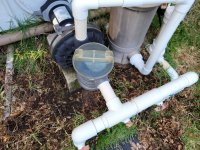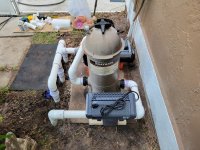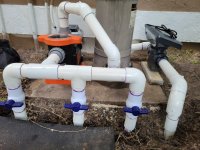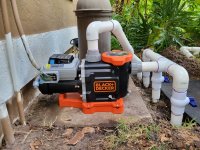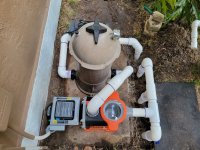- May 10, 2024
- 18
- Pool Size
- 17000
- Surface
- Plaster
- Chlorine
- Salt Water Generator
- SWG Type
- CircuPool Core-35
Hi all,
The home I just moved into has a ~17,000 gal pool. The pump is a single-speed Sta-Rite Dura-Glas P2RA5E-124L with Century HSQ125 motor (I think it is 230V 1-phase). I'm guessing the pump is around 2 ft above the pool water surface, and the pump is located around 6 ft from the corner of the pool. There is a Hayward C9002 cartridge filter, 1.5" plumbing with three suction lines (L to R in photo): pool drain, skimmer, and vacuum. And no, the pump and piping are not level or plumb. The pump is tilted as much as 5 degrees from horizontal. The suction pipes are not vertical, so I'm guessing the whole mess just settled over the years and it is what it is unless I can fix it with 11-degree fittings or something. The vacuum is a Hayward Navigator Pro W3925ADC. The previous owner had a solar pool heater on the roof, but removed it when they changed shingles. Water is piped from the pump outlet to the filter, then from the filter it goes through the old heater pipes to the left, up to the diverter valve, then back to the right and into the chlorinator before I assume it goes underground and on to the pool returns. There are 5 outlets around the perimeter of the pool. The previous owner was running the pump 3 hours a day, which I suspect is not even close to sufficient and was probably done to save money with the single-speed pump. I would like to replace the pump with a VS model, and was thinking about buying one of the Calimar options since they are supposed to be the same as the B&D (and others) but for much lower cost. I'd still consider the B&D if better or if 2hp is the "right" size for me to use. I was going to just go for the 3hp VS pump, but I read some things about 1.5" pipes that worried me a bit. I would have thought I could just run the pump at lower speeds and then schedule it to run for 2 hours at whatever max speed is needed to equal the current flow rate, then 10 hours at a mid speed and 12 hours at low to keep water circulating 24 hours a day.
I plan to do the work myself, and am also planning to install a salt chlorine generator, possibly a CircuPool Core-35 or Core-45. I'm also planning to remove all of the 2" plumbing that used to go to the solar heaters since it's just creating unnecessary headloss at the moment and gives me more potential locations for leaks in the future. I will also remove the pin timer for the existing pool pump since the VS pumps have their own control panels with 4 speed settings that I can program.
I would really appreciate any recommendations/explanations. Thanks!
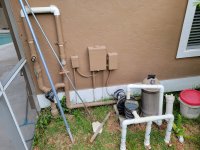
The home I just moved into has a ~17,000 gal pool. The pump is a single-speed Sta-Rite Dura-Glas P2RA5E-124L with Century HSQ125 motor (I think it is 230V 1-phase). I'm guessing the pump is around 2 ft above the pool water surface, and the pump is located around 6 ft from the corner of the pool. There is a Hayward C9002 cartridge filter, 1.5" plumbing with three suction lines (L to R in photo): pool drain, skimmer, and vacuum. And no, the pump and piping are not level or plumb. The pump is tilted as much as 5 degrees from horizontal. The suction pipes are not vertical, so I'm guessing the whole mess just settled over the years and it is what it is unless I can fix it with 11-degree fittings or something. The vacuum is a Hayward Navigator Pro W3925ADC. The previous owner had a solar pool heater on the roof, but removed it when they changed shingles. Water is piped from the pump outlet to the filter, then from the filter it goes through the old heater pipes to the left, up to the diverter valve, then back to the right and into the chlorinator before I assume it goes underground and on to the pool returns. There are 5 outlets around the perimeter of the pool. The previous owner was running the pump 3 hours a day, which I suspect is not even close to sufficient and was probably done to save money with the single-speed pump. I would like to replace the pump with a VS model, and was thinking about buying one of the Calimar options since they are supposed to be the same as the B&D (and others) but for much lower cost. I'd still consider the B&D if better or if 2hp is the "right" size for me to use. I was going to just go for the 3hp VS pump, but I read some things about 1.5" pipes that worried me a bit. I would have thought I could just run the pump at lower speeds and then schedule it to run for 2 hours at whatever max speed is needed to equal the current flow rate, then 10 hours at a mid speed and 12 hours at low to keep water circulating 24 hours a day.
I plan to do the work myself, and am also planning to install a salt chlorine generator, possibly a CircuPool Core-35 or Core-45. I'm also planning to remove all of the 2" plumbing that used to go to the solar heaters since it's just creating unnecessary headloss at the moment and gives me more potential locations for leaks in the future. I will also remove the pin timer for the existing pool pump since the VS pumps have their own control panels with 4 speed settings that I can program.
I would really appreciate any recommendations/explanations. Thanks!

Last edited:


